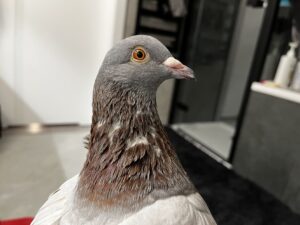Pigeons are wonderful birds to have around, and more and more people are choosing to keep them. They’re not just fun to watch, but they also bring a lot of joy to their owners. If you’re thinking about keeping pigeons, it’s really important to give them a good home. This means building a coop that’s safe, cozy, and has everything they need. In this article, we’re going to show you exactly how to do that.
Building a pigeon coop might seem like a big job, but don’t worry – we’ve got you covered. We’ll walk you through everything you need to know, from understanding what pigeons need, to choosing the right place for the coop, and even the materials and steps you need to build it. By the end of this guide, you’ll have all the information you need to create the perfect home for your feathered friends.
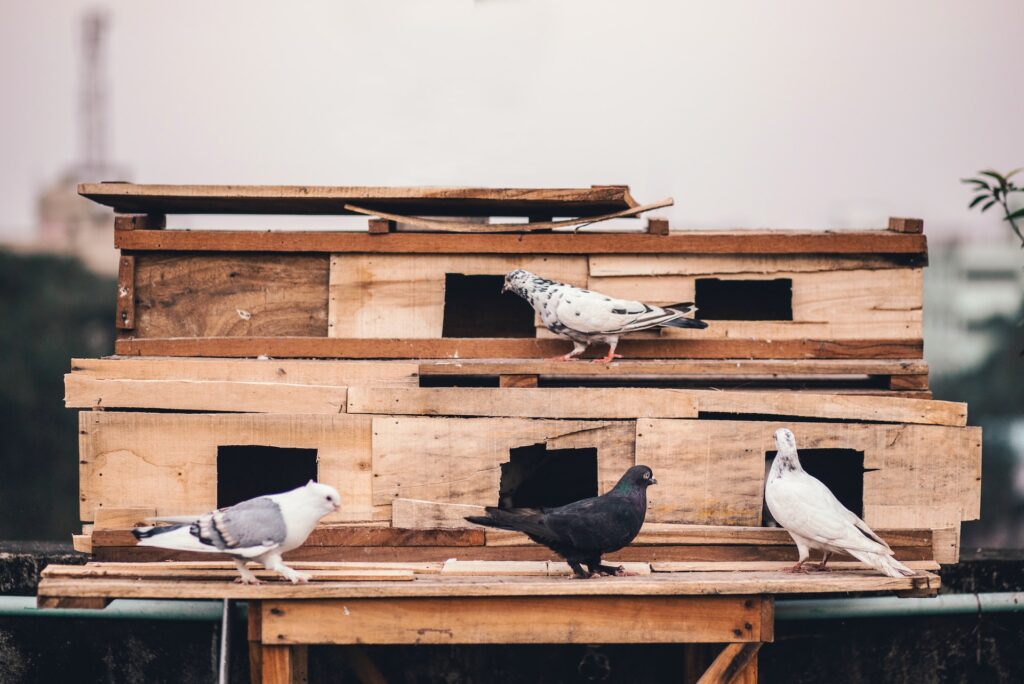
How to Build a Pigeon Coop? Table of Contents
Understanding Pigeon Needs
Space Requirements for Pigeons Pigeons need enough space to live happily and healthily. Let’s break down what that means:
- Recommended Size and Space Per Pigeon: A good rule of thumb is to have at least 2-3 square feet of space per pigeon. So, if you plan on having 10 pigeons, you would need a coop that is at least 20-30 square feet. This gives them enough room to move around and spread their wings.
- Importance of Ventilation and Light: Pigeons need fresh air and natural light just like we do. Make sure your coop has plenty of ventilation to let fresh air in and stale air out. Windows can provide natural light, but make sure they are covered with wire mesh to keep predators out.
Safety Considerations Keeping your pigeons safe is super important. Here are some things to think about:
- Protecting Pigeons from Predators: Pigeons have a lot of natural enemies like cats, rats, and birds of prey. Make sure the coop is secure so these predators can’t get in. Use strong materials and make sure there are no gaps or holes.
- Safe Materials and Construction Practices: Use non-toxic materials to build your coop. If you’re using wood, make sure it’s untreated since treated wood can be harmful to pigeons. Also, ensure that any nails or screws are properly secured so that pigeons don’t hurt themselves.
Comfort and Enrichment Pigeons need more than just a safe space; they need a home. Here’s how to make your coop comfortable and interesting for them:
- Perches and Roosting Areas: Pigeons like to perch. Provide plenty of perches and roosting areas so they can rest comfortably.
- Nesting Boxes and Materials: If you have a mix of male and female pigeons, they may want to nest. Provide nesting boxes and materials like straw or wood shavings.
- Additional Features for Enrichment: Pigeons are smart and like to stay busy. You can add features like ladders, swings, or even toys to keep them entertained.
By understanding and catering to these needs, you’ll create a space that your pigeons will love to call home!
Check my article about Why Are Pigeon Nests So Bad?
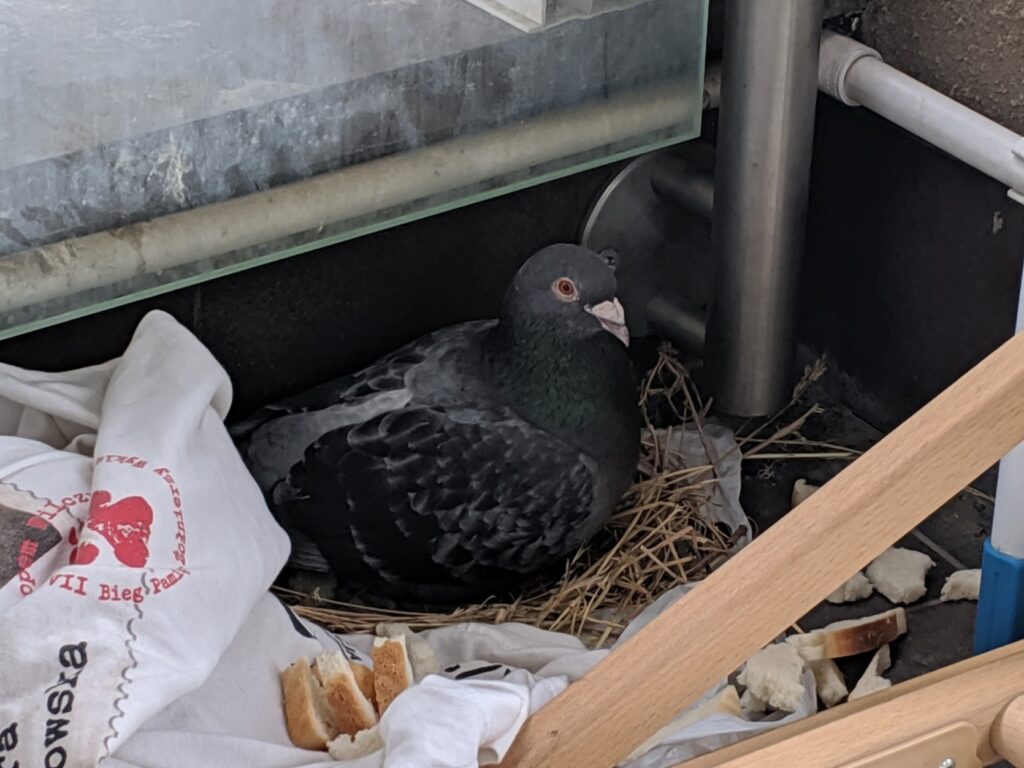
How to Build a Pigeon Coop? Choosing the Right Location
When you’re thinking about where to put your pigeon coop, there are several important factors to consider. You want to make sure that the location is just right so your pigeons can be safe, happy, and healthy.
Factors to Consider When Selecting a Site for Your Pigeon Coop Firstly, think about how much sunlight the area gets. Pigeons need a good amount of natural light, but they also need some shade to protect them from the hot sun. Also, consider the direction of the wind and try to place the coop where it will be sheltered from strong winds. You’ll also want to make sure the site is dry and not prone to flooding. Pigeons don’t like to be damp, and a wet living space can lead to health problems. Additionally, consider how easy it will be for you to access the coop for cleaning and feeding.
Pros and Cons of Different Locations If you’re thinking about putting the coop on the ground, the main advantage is that it’s easy to build and maintain. However, it might be more accessible to predators. On the other hand, an elevated coop can protect your pigeons from predators and might provide better ventilation. The downside is that it might be more difficult to build and maintain. In terms of exposure to the elements, a spot that gets a mix of sunlight and shade is ideal. You want to avoid places that are completely exposed as this can lead to overheating in summer, and also avoid areas that are too shady, as your pigeons need plenty of light.
Tips for Ensuring Easy Access and Maintenance Make sure that you place the coop in a spot where it’s easy for you to get to every day. You’ll need to feed your pigeons, provide fresh water, and clean the coop regularly. If the coop is hard to access, these chores can become more difficult and time-consuming. Also, consider the future: you might want to expand the coop or add additional features down the line, so leave some extra space if possible.
In summary, choosing the right location for your pigeon coop is a crucial step that will impact the health and happiness of your pigeons. Take the time to consider all of these factors and choose a site that meets all of the necessary criteria.
Check my article about Do Pigeons Make Nests?
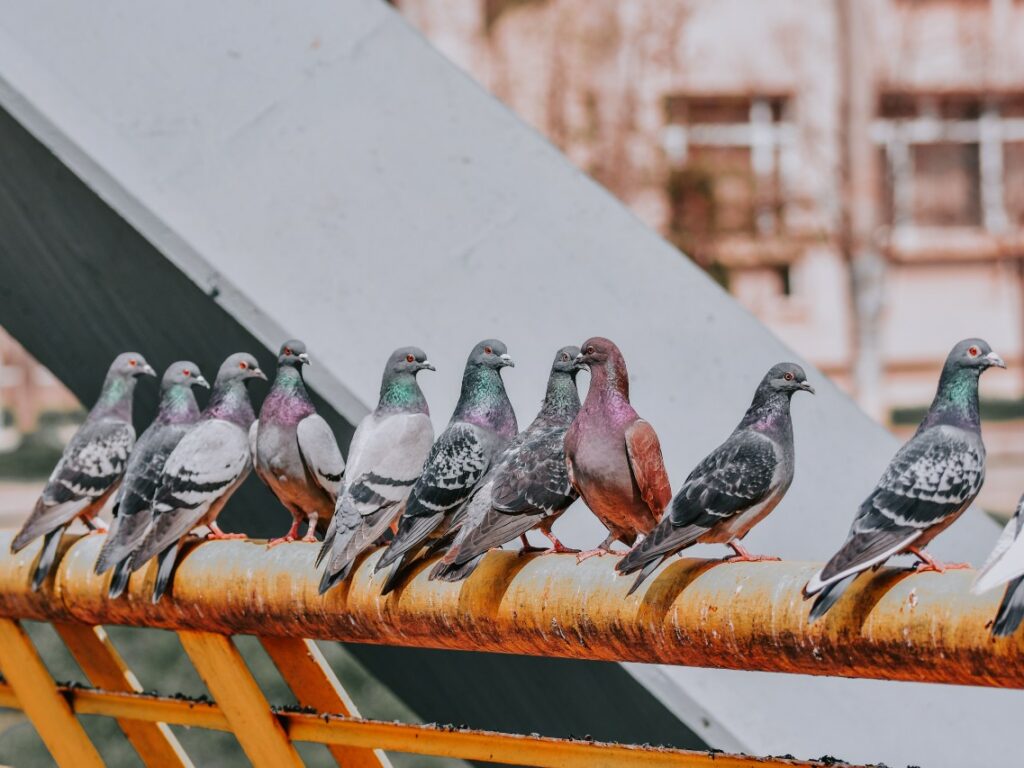
Materials and Tools Required
Building a pigeon coop requires careful planning and the right materials and tools. Below is a detailed list to help guide you through the process.
Comprehensive List of Materials Needed for Building a Pigeon Coop
- Wood: For constructing the frame, walls, and roof of the coop.
- Wire Mesh: To cover windows and any open spaces, ensuring ventilation while keeping predators out.
- Nails or Screws: For securing the wood and wire mesh together.
- Hinges and Latches: For creating doors that can open and close securely.
- Perches: Can be made from dowels or branches for the pigeons to roost on.
- Nesting Boxes: Wooden boxes or crates that can be filled with straw or shavings for nesting.
- Roofing Material: Such as shingles or a metal sheet to protect from the weather.
- Paint or Sealant: Non-toxic options to protect the wood and add a finishing touch.
- Straw or Wood Shavings: For bedding and nesting material.
- Feeding and Watering Stations: Bowls or containers for food and water.
Overview of Tools Required for the Construction Process
- Saw: For cutting the wood to the required sizes.
- Hammer or Screwdriver: Depending on whether you are using nails or screws.
- Wire Cutters: For cutting the wire mesh.
- Measuring Tape: To ensure accuracy in your measurements.
- Level: To make sure everything is straight and even.
- Drill: If you are using screws, a drill will make the process easier.
- Paintbrush or Roller: For applying the paint or sealant.
Recommendations for Sustainable and Durable Materials
When choosing materials for your pigeon coop, it’s important to consider both sustainability and durability. Opt for wood that has been sustainably sourced and ensure any paint or sealant used is non-toxic to birds. Galvanized wire mesh is a durable option for covering windows and openings, as it is resistant to rust. For the roof, metal sheets are a durable choice and can also be recycled at the end of their life. Choosing high-quality materials might be more expensive upfront, but they will last longer and provide a safer home for your pigeons in the long run.
Step-by-Step Guide to Building a Pigeon Coop
Building a pigeon coop requires careful planning and execution. Follow this step-by-step guide to create a safe and comfortable home for your pigeons.
Preparing the Site
- Clearing and Leveling the Ground: Start by choosing the perfect spot for your pigeon coop and clear away any debris, rocks, or vegetation. Use a level to make sure the ground is even. An uneven surface could make the coop unstable.
- Laying the Foundation (if necessary): If the ground is very uneven or prone to dampness, you might need to lay a foundation. This could be a simple layer of concrete or paving slabs to provide a stable and dry base for the coop.
Constructing the Frame
- Building the Walls and Roof: Using the wood, cut pieces to the required sizes and start to assemble the walls. Make sure everything is secure and stable before attaching the roof. The roof should have a slight slope to allow rainwater to run off.
- Installing Doors and Windows: Cut spaces for doors and windows in the walls. Install hinges on the doors and attach them securely. Cover windows with wire mesh to keep predators out while allowing light and air in.
Adding the Interior Features
- Installing Perches and Nesting Boxes: Inside the coop, install perches at different heights so the pigeons have plenty of options for roosting. Place nesting boxes in quieter corners to provide a safe space for laying eggs.
- Adding Feeding and Watering Stations: Set up bowls or containers for food and water. Make sure they are easy to access for both the pigeons and yourself for refilling and cleaning.
Finishing Touches
- Painting or Sealing the Coop for Protection: Once everything is in place, paint or seal the wood to protect it from the weather. Ensure that any products used are non-toxic to birds.
- Adding Any Additional Features for Comfort and Enrichment: Consider adding features such as ladders, swings, or toys to keep the pigeons entertained. You might also want to add extra perches or shelters outside the coop for the pigeons to enjoy during the day.
By following these steps, you can build a sturdy and comfortable pigeon coop that will provide a safe home for your birds for years to come. Remember to regularly check and maintain the coop to ensure it remains in good condition.
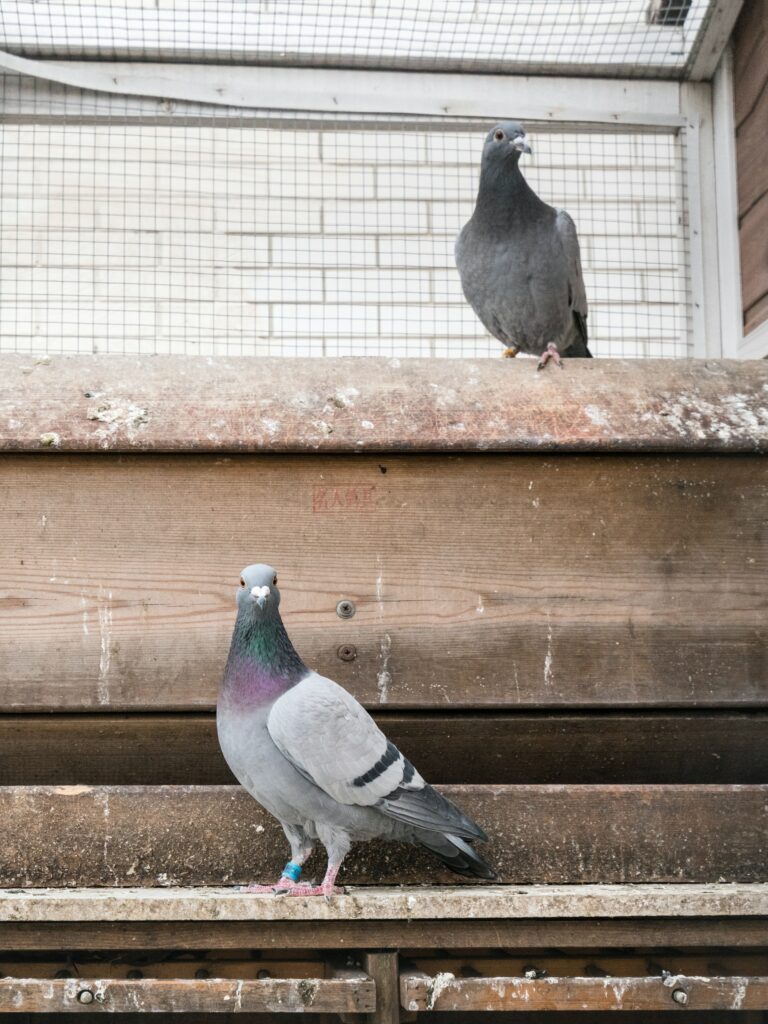
Maintenance and Care of Your Pigeon Coop
Taking good care of your pigeon coop is crucial to ensure a healthy and safe environment for your birds. Here’s how you can maintain and care for your pigeon coop:
Routine Cleaning and Sanitation Practices
Regular cleaning is a must. Every day, remove any leftover food and change the water to keep it fresh. Weekly, clean out the bedding in the nesting boxes and replace it with fresh material. Scrub the feeding and watering stations to prevent any buildup of dirt or germs. Monthly, do a thorough cleaning of the entire coop. This means taking out all the perches, nesting boxes, and other items inside the coop and cleaning them. Also, scrub the walls and floor of the coop to remove any dirt or droppings. Use a bird-safe disinfectant to sanitize the coop and prevent the spread of diseases.
Seasonal Maintenance Tasks
Apart from the regular cleaning, you should also do some seasonal maintenance to ensure the coop is in top condition. In spring, check the coop for any signs of damage caused by winter weather and repair as necessary. This is also a good time to check for and get rid of any pests like mites or lice. In summer, make sure the coop is well-ventilated and provide extra water to help the pigeons stay cool. In fall, prepare the coop for winter by checking that it’s waterproof and free from drafts. In winter, make sure the pigeons are warm enough and that any snow or ice is cleared away from the coop.
Signs of Wear and Tear to Watch Out For
Regularly inspect the coop for any signs of wear and tear. Look for any holes or gaps in the walls or floor and repair them immediately to prevent predators from getting in. Check the roof to ensure it’s in good condition and not leaking. Also, look at the perches, nesting boxes, and other interior features to make sure they’re secure and not broken. If you notice any worn-out or damaged parts, replace them as soon as possible to keep the coop safe and comfortable for your pigeons.
By following these maintenance and care practices, you can keep your pigeon coop in good condition and provide a safe and healthy home for your birds. Remember, a clean and well-maintained coop is key to keeping your pigeons happy!
Check my article about Where Do Pigeons Live?
How to Build a Pigeon Coop? Tips and Best Practices
Keeping pigeons can be a rewarding experience, but it comes with its own set of challenges. Here are some tips and best practices to help you along the way, especially if you are new to pigeon keeping.
Advice for First-Time Pigeon Keepers
If you are new to keeping pigeons, start small. Don’t get too many birds until you are comfortable with caring for them. Spend time with your pigeons every day so they get used to your presence. This also allows you to observe their behavior and notice any signs of illness or distress early on. Make sure their diet is balanced and nutritious, and always provide fresh water. Remember, pigeons are social birds, so they should be kept in pairs or groups to prevent loneliness.
Troubleshooting Common Issues
If your pigeons are not behaving as usual, it could be a sign of illness or stress. Watch out for symptoms like lack of energy, puffing up feathers, or changes in eating and drinking habits. If you notice any of these signs, consult a veterinarian experienced with birds. Ensure that the coop is secure to prevent predators from getting in, as this can cause stress to the pigeons. If your pigeons are pecking at each other, this could be a sign of overcrowding or boredom, so provide more space or enrichment activities.
Resources for Further Learning and Support
There are plenty of resources available for pigeon keepers, from books and websites to local clubs and online forums. Look for books on pigeon care and breeding for in-depth information. Websites of pigeon keeping organizations can provide helpful articles, guides, and support. Joining a local pigeon club or online forum can connect you with experienced pigeon keepers who can offer advice and support. Don’t be afraid to reach out and ask questions; the pigeon keeping community is usually very welcoming and happy to help newcomers.
By following these tips and best practices, and taking advantage of the available resources, you can create a thriving and happy environment for your pigeons. Remember, keeping pigeons is a learning experience, and there is always more to learn and discover about these fascinating birds.
Final Thoughts
Building a pigeon coop and taking care of pigeons can be a lot of work, but it’s also very rewarding. These birds are smart, social, and fun to be around. By following the steps and advice in this article, you can create a safe and comfortable home for your pigeons.
Remember, it’s important to think about what pigeons need and make sure they have enough space, safety, and things to do. Choose a good place for the coop, use the right materials, and put in the necessary features like perches, nesting boxes, and feeding stations.
Keep the coop clean and well-maintained, and watch out for any signs of problems. Don’t forget, there are lots of resources and fellow pigeon keepers out there who can help if you have questions or need advice.
Whether you are new to keeping pigeons or have been doing it for a while, there is always more to learn. So, keep learning, take good care of your birds, and enjoy all the fun and companionship they bring. Happy pigeon keeping!
How to Build a Pigeon Coop? FAQs
What size should my pigeon coop be?
The size of your pigeon coop will depend on how many pigeons you plan to keep. Each pigeon needs about 2-3 square feet of space. Make sure to provide enough room for them to move around and fly.
Why is ventilation important in a pigeon coop?
Ventilation is crucial because it ensures a flow of fresh air, which helps to keep the coop dry and prevents the buildup of harmful gases. It also helps to regulate the temperature inside the coop.
How do I protect my pigeons from predators?
Make sure the coop is secure and built with strong materials. Use wire mesh on windows and any openings to prevent predators from getting in. Regularly inspect the coop for any signs of wear and tear and fix any gaps or holes immediately.
What kind of perches should I provide in the coop?
Provide a variety of perches at different heights and positions. You can use dowels, branches, or even special pigeon perches available in pet stores. Ensure they are placed in such a way that droppings do not fall onto food or other pigeons.
What materials are safe to use for building a pigeon coop?
Use untreated wood, as treated wood can be toxic to pigeons. Make sure any paint or sealant used is non-toxic. Avoid using any materials that can easily be chewed or pecked through.
How often should I clean the pigeon coop?
Remove droppings and leftover food daily. Do a thorough cleaning of the coop, including changing the bedding in the nesting boxes, at least once a week. Perform a deep clean and disinfection of the entire coop once a month.
What should I consider when choosing a location for my pigeon coop?
Choose a location that is safe from predators and extreme weather conditions. Make sure the coop is elevated to prevent dampness. Ensure that it is easily accessible for cleaning and maintenance.
What additional features can I add for pigeon enrichment?
You can add features such as ladders, swings, or hanging toys to provide stimulation for the pigeons. Providing a variety of perches and nesting materials can also contribute to their well-being.
How can I learn more about pigeon keeping?
There are many resources available for pigeon keepers, including books, websites, and online forums. Joining a local pigeon club can also provide you with support and advice from experienced pigeon keepers.
Can I build a pigeon coop myself or should I hire a professional?
If you have basic carpentry skills, you can build a pigeon coop yourself using readily available materials and tools. However, if you are unsure, it might be worth hiring a professional to ensure the coop is built securely and safely.


